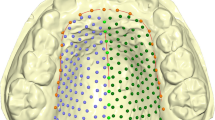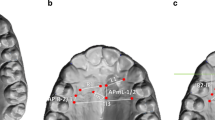Abstract
This study tested the hypothesis that developmental heterogeneity in cranial base morphology increases the prevalence of Class III malocclusion and mandibular prognathism in Asians. Thin-plate spline (TPS) graphical analysis of lateral cephalometric radiographs of the cranial base and the upper midface configuration were compared between a European-American group (24 females and 31 males) and four Asian ethnic groups (100 Chinese, 100 Japanese, 100 Korean and 100 Taiwanese; 50 females and 50 males per group) of young adults with clinically acceptable occlusion and facial profiles. Procrustes analysis was performed to identify statistically significant differences in each configuration of landmarks (P < 0.001). The TPS graphical analysis revealed that the greatest differences of Asians were the horizontal compression and vertical expansion in the anterior portion of the cranial base and upper midface region. The most posterior cranial base region also showed horizontal compression between the basion and Bolton point, with forward displacement of the articulare. Facial flatness and anterior displacement of the temporomandibular joint, resulting from a relative retrusion of the nasomaxillary complex and a relative forward position of the mandible were also noted. These features that tend to cause a prognathic mandible and/or retruded midface indicate a morphologic predisposition of Asian populations for Class III malocclusion.


Similar content being viewed by others
References
Susami R, Asai Y, Hirose K, Hosoi T, Hayashi I. The prevalence of malocclusion in Japanese school children. J Jpn Orthod Soc. 1972;31:319–24.
Chang HP. Components of Class III malocclusion in Taiwanese. Kaohsiung J Med Sci. 1985;1:144–55.
Kang HK, Ryu YK. A study on the prevalence of malocclusion of Yonsei University students in 1991. Korean J Orthod. 1992;22:691–701.
Zeng XL. A study of skeletal types of Class III malocclusion. Chin J Stomatol. 1993;28:170–73, 191.
Moyers RE, Bookstein FL. The inappropriateness of conventional cephalometrics. Am J Orthod. 1979;75:599–617.
Bookstein FL. On the cephalometrics of skeletal change. Am J Orthod. 1982;82:177–98.
Richtsmeier JT, Cheverud JM, Jele S. Advances in anthropological morphometrics. Ann Rev Anthropol. 1992;21:283–305.
Rohlf FJ, Marcus LF. A revolution in morphometrics. Trends Ecol Evol. 1993;8:129–32.
Bookstein FL. Principal warps: thin-plate splines and the decomposition of deformations. IEEE Trans Pattern Anal Mach Intell. 1989;11:567–85.
Bookstein FL. Morphometric tools for landmark data. Cambridge: Cambridge University Press; 1991.
Enlow DH, Hans MG. Essentials of facial growth. Philadelphia: W.B. Saunders; 1996.
Chang HP, Huang HH. Craniofacial pattern of young adults with various types of malocclusion. Kaohsiung J Med Sci. 1998;14:168–76.
Gkantidis N, Halazonetis DJ. Morphological integration between the cranial base and the face in children and adults. J Anat. 2011;218:426–38.
Ishii N, Deguchi T, Hunt NP. Morphological difference in the craniofacial structure between Japanese and Caucasian girls with Class II division 1 malocclusions. Eur J Orthod. 2002;24:61–7.
Rosner B. Fundamentals of biostatistics. 7th ed. Belmont: Thomson–Brooks/Cole; 2011.
Gower JC. Generalized Procrustes analysis. Psychometrika. 1975;40:33–51.
Rohlf FJ, Slice D. Extensions of the Procrustes method for the optimal superimposition of landmarks. Syst Zool. 1990;39:40–59.
Goodall CR. Procrustes methods in the statistical analysis of shape. J Royal Stat Soc. 1991;B53:285–339.
Rohlf FJ. Statistical power comparisons among alternative morphometric methods. Am J Phys Anthropol. 2000;111:463–78.
Dahlberg G. Statistical methods for medical and biological students. London: George Allen and Unwin; 1940. p. 122–32.
Houston WJB. The analysis of errors in orthodontic measurements. Am J Orthod. 1983;83:382–90.
Swiderski DL. Morphological evolution of the scapula in three squirrels, chipmunks, and ground squirrels (Sciuridae): an analysis using thin-plate spline. Evolution. 1993;47:1854–73.
Yaroch LA. Shape analysis using the thin-plate spline: Neanderthal cranial shape as an example. Yrbk Phys Anthropol. 1996;39:43–89.
Yamaguchi B. Facial flatness measurements of the Ainu and Japanese crania. Bull Natl Sci Mus Tokyo. 1973;16:161–71.
Dodo Y. A study of the facial flatness in several cranial series from East Asia and North America. J Anthrop Soc Nippon. 1986;94:81–93.
Ishida H. Flatness of facial skeletons in Siberian and other circum-Pacific populations. Z Morphol Anthropol. 1992;79:53–67.
Hopkin GB, Houston WJB, James GA. The cranial base as an aetiological factor in malocclusion. Angle Orthod. 1968;38:250–5.
Ma W, Lozanoff S. Spatial and temporal distribution of cellular proliferation in the cranial base of normal and midfacially retrusive mice. Clin Anat. 1999;12:315–25.
Jacobson A, Evans WG, Preston CB, Sadowsky PL. Mandibular prognathism. Am J Orthod. 1974;66:140–71.
Innocenti C, Giuntini V, Defraia E, Baccetti T. Glenoid fossa position in Class III malocclusion associated with mandibular protrusion. Am J Orthod Dentofacial Orthop. 2009;135:438–41.
Ishii N, Deguchi T, Hunt NP. Craniofacial differences between Japanese and British Caucasian females with a skeletal Class III malocclusion. Eur J Orthod. 2002;24:493–9.
Seren E, Akan H, Toller MO, Akyar S. An evaluation of the condylar position of the temporomandibular joint by computerized tomography in Class III malocclusions. Am J Orthod Dentofacial Orthop. 1994;105:483–8.
Cohlmia JT, Ghosh J, Sinha PK, Nanda RS, Currier GF. Tomographic assessment of temporomandibular joints in patients with malocclusion. Angle Orthod. 1996;66:27–35.
Alkhamrah B, Terada K, Yamaki M, Ali IM, Hanada K. Ethnicity and skeletal Class III morphology: a pubertal growth analysis using thin-plate spline analysis. Int J Adult Orthod Orthognath Surg. 2001;16:243–54.
Singh GD, McNamara JA Jr, Lozanoff S. Thin-plate spline analysis of the cranial base in subjects with Class III malocclusion. Eur J Orthod. 1997;19:341–53.
Bhat M, Enlow DH. Facial variations related to headform type. Angle Orthod. 1985;55:269–80.
Siriwat PP, Jarabak JR. Malocclusion and facial morphology is there a relationship? An epidemiologic study. Angle Orthod. 1985;55:127–38.
Proffit WR, Fields HW, Moray LJ. Prevalence of malocclusion and orthodontic treatment need in the United States: estimates from the NHANES III survey. Int J Adult Orthod Orthognath Surg. 1998;13:97–106.
Rosas A, Bastir M, Alarcón JA, Kuroe K. Thin-plate spline analysis of the cranial base in African, Asian and European populations and its relationship with different malocclusions. Arch Oral Biol. 2008;53:826–34.
Sanborn RT. Differences between the facial skeletal patterns of Class III malocclusion and normal occlusion. Angle Orthod. 1955;25:208–22.
Chang HP, Hsieh SH, Tseng YC, Chou TM. Cranial-base morphology in children with Class III malocclusion. Kaohsiung J Med Sci. 2005;21:159–65.
Williams S, Anderson CE. The morphology of the potential Class III skeletal pattern in the growing child. Am J Orthod. 1986;89:302–11.
Polat ÖÖ, Kaya B. Changes in cranial base morphology in different malocclusion. Orthod Craniofacial Res. 2007;10:216–21.
Battagel JM. The aetiology of Class III malocclusion examined by tensor analysis. Br J Orthod. 1993;20:283–95.
Battagel JM. Predictors of relapse in orthodontically-treated Class III malocclusions. Br J Orthod. 1994;21:1–13.
Bastir M, Rosas A, Kuroe K. Petrosal orientation and mandibular ramus breadth: evidence of a developmental integrated petroso-mandibular unit. Am J Phys Anthropl. 2004;123:340–50.
Baccetti T, Antonini A, Franchi L, Tonti M, Tollaro I. Glenoid fossa position in different facial types: a cephalometric study. Br J Orthod. 1997;24:55–9.
Dhopatkar A, Bhatia SN, Rock P. An investigation into the relationship between the cranial base angle and malocclusion. Angle Orthod. 2002;72:456–63.
Acknowledgments
This work was supported by the National Science Council of Taiwan (NSC 89-2314-B037-058, NSC 89-2314-B037-181 and NSC 90-2314-B-037 -087). We are grateful to Drs. R. Behrents, T. Kawamoto, S. Oh and H. Zhao for permission to obtain cephalometric radiographs/data in this study.
Conflict of interest
None of the authors have any conflicts of interest associated with this study.
Author information
Authors and Affiliations
Corresponding authors
Additional information
H.-P. Chang and P.-H. Liu equally contributed to this work.
Rights and permissions
About this article
Cite this article
Chang, HP., Liu, PH., Tseng, YC. et al. Morphometric analysis of the cranial base in Asians. Odontology 102, 81–88 (2014). https://doi.org/10.1007/s10266-012-0096-8
Received:
Accepted:
Published:
Issue Date:
DOI: https://doi.org/10.1007/s10266-012-0096-8




